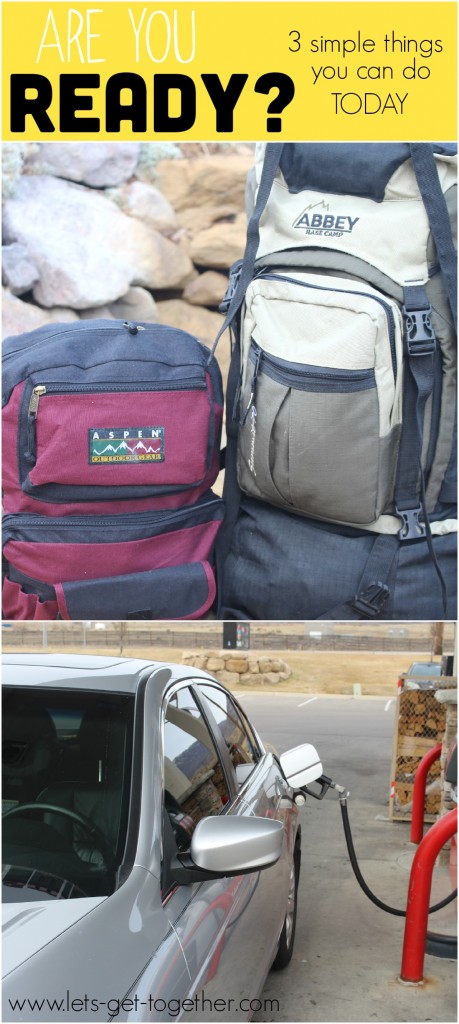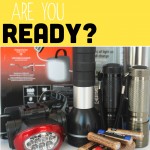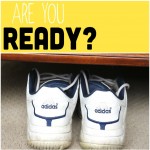Several years ago on a Sunday afternoon our family got a phone call from a church friend/leader. He challenged us to spend the next three days sleeping outside in a tent and living solely on food and supplies we had at home. We were asked not to go to the store or use the TV or computer except for work and school. A few other families were participating, then after our “experiment” we would talk about what we had learned. We survived our 72 hours just fine (other than missing out on some NBA games.) The kids loved sleeping outside and even the dog joined us in the tent! But we still learned some important things and realized that emergency preparation should be on-going.
Did you do some preparing last month? Here are some suggestions for this month:
1. Always keep your gas tank at least half full. It doesn’t take much time and it’s just a good habit to develop. In 2005, thousands of people in Houston were urged to evacuate before Hurricane Rita. Gas stations were quickly emptied and thousands were stranded without gas.
A few years ago we got caught in a blizzard for nearly five hours. Many cars were abandoned in the middle of the road because they ran out of gas. (I can’t imagine having to leave your car and brave the blizzard!)
2. Learn how to override your electric garage door opener in case there is a power outage. One day I was hurrying home to teach piano lessons. The power was out and I couldn’t get in the garage. I didn’t have the house key with me either. (Other lesson here – always carry your house key.) This bad situation turned funny as I ended up teaching at the students’ home. We had no power/lights but the mom gave us headlamps so we could still have piano lessons! Learn how to override your electric garage door here.
3. Prepare a 3-day emergency supply kit. If you already have one, make sure you update it every 6 months to rotate food, and make sure clothes still fit and batteries are working etc. There was a year when we forgot to do that and my son had grown a lot. He pulled on the pants we’d packed for him and they looked more like knickers! And there was no way those briefs we’re going to fit him anymore! Put items in a backpack or another portable container that’s easy to grab and go.
The kit can include the following:
– Water – 1 gallon per person per day
– 3 day supply of food – jerky, trail mix, protein or granola bars, dehydrated foods, non perishable, freeze dried, MRE’s
– Lightweight stove and fuel if needed
– Flashlight and/or light sticks – kept at the top of your kit for easy access
– Radio – battery operated or hand-crank
– Batteries
– Whistle
– Filter masks
– Pocket knife
– Emergency cash in small denominations and quarters
– Sturdy shoes, a change of clothes, underwear, dry socks, and a warm hat
– First aid kit
– Local map
– Moist towelettes, toilet paper, garbage bags and ties for personal sanitation
– Cell phones and chargers
– List of emergency contact numbers
– List of drug or food allergies
– Prescription medications
– Toothbrushes and toothpaste
– Extra keys to your house and vehicle
– Personal sanitation items and/or special needs items
– Sleeping bag or warm blanket
– Mess kit, paper cups, plates, plastic utensils, paper towels
– Matches or fire starter in water proof container
– Small tent or plastic sheets to make a shelter
– Rope or parachute cord
– Rain coat or poncho
– Copy of health insurance and identification cards
– Games, books, paper, markers and tape (entertain the kids- avoid boredom)
– Hard candy or gum – stress reliever
Resolve to be ready in 2015! Check back next month for more ways to prepare.







A very helpful idea, these are the important things you can bring in times of emergency. If you are already prepared, you can just grab your bag and go. Thanks and I am looking forward to read more of your article.
Your idea will help a lot on how to be prepared in any emergency situation, but I would just like to add that being EMOTIONALLY prepared will help you think the right things to do during emergency.